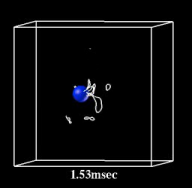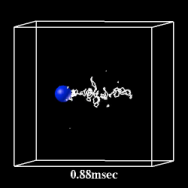Gallery of our numerical simulations
Analysis based on the quantized vortex line approximation
Coupled dynamics of micron-sized particles and quantized vortices
Particle-tracking velocimetry experiments[1], which is a technique for visualizing fluid flow using small particles, have been performed to investigate counterflow of superfluid 4He by Maryland group.They visualized thermal counterflow by using micron-sized solid hydrogen tracer particles.The tracer particles were observed to divide into two groups: particles which move freely in the direction of the normal fluid, and particles which are trapped into vortex lines and move in the opposite direction. We succeeded to reproduce the dynamics of their experiment by numerical simulation and obtained the results similar to the experiment.
[1] M.S. Paoletti, R.B. Fiorito, K.R. Sreenivasan, and D.P. Lathrop J. Phys. Soc. Jpn. 77, 111007 (2008)
Turbulence in boundary flow of superfluid 4He triggered by free vortex rings
Detail are shown here

 Quantum turbulence created by vibrating grid
The experimental group of Lancaster university reported the success of controlling the transition from laminar to turbulent state of superfluid 3He-B by a vibrating grid and observing it by Andreev scattering.[1] We succeeded to reproduce the situation of their experiment by numerical simulations and support their observation of the generation process of quantum turbulence near zero temperature.
Quantum turbulence created by vibrating grid
The experimental group of Lancaster university reported the success of controlling the transition from laminar to turbulent state of superfluid 3He-B by a vibrating grid and observing it by Andreev scattering.[1] We succeeded to reproduce the situation of their experiment by numerical simulations and support their observation of the generation process of quantum turbulence near zero temperature.
[1] D. I. Bradley et al. Phys. Rev. Lett. 95, 035302 (2005)
- turbulent state with strong vibration
- laminar state with weak vibration
The Lancaster group also discovered that the turbulence created by the vibrating grid desplays decay of t-3/2, characteristic of turbulence which obeys Kolmogorov law.[2] This type of decay was also confirmed in our simulation.
[2] D. I. Bradley et al. Phys. Rev. Lett. 96, 035301 (2006)
- decay of quantum turbulence
Kelvin-wave cascade on a quantized vortex line in superfluid 4He
A study by computer simulation is reported of the behaviour of a quantized vortex line at a very low temperature when there is continuous excitation of low-frequency Kelvin waves. There is no dissipation except by phonon radiation at a very high frequency. It is shown that non-linear coupling leads to a net flow of energy to higher wavenumbers and to the development of a simple spectrum of Kelvin waves that is insensitive to the strength and frequency of the exciting drive. The results are likely to be relevant to the decay of turbulence in superfluid $^4$He at very low temperatures.
W.F. Vinen, M. Tsubota, A. Mitani, Phys. Rev. Lett. 91, 135301 (2003)
Transition to superfluid turbulence governed by an intrinsic parameter
The experimental group of Helsinki university discovered in hydrodynamics of the B phase of superfluid 3He that a sharp transition at 0.60Tc between two regimes, with regular behaviour at high-temperatures and turbulence at low-temperatures. Unlike in classical fluids, this transition is insensitive to velocity and occurs at a temperature where the dissipative vortex damping drops below a critical limit. At high temperatures in rotating flow a vortex loop injected into superflow has been observed to expand monotonically to a single rectilinear vortex line, while at very low temperatures a tangled network of quantized vortex lines can be generated. Our numerical simulation support this experimental observation, where the left and right movie show the vortex dynamics at high (T=0.8Tc) and low temperature (T=0.4Tc), respectively. The solution of this conflict reveals a new intrinsic criterion for the existence of superfluid turbulence.
A.P. Finne, T. Araki, R. Blaauwgeers, V. B. Eltsov, N. B. Kopnin, M. Krusius, L. Skrbek, M. Tsubota & G.E. Volovik,
Nature (London) 424, 1022 (2003)
Rotating superfluid turbulence
Almost all studies of vortex states in helium II have been concerned with either ordered vortex lattices or disordered vortex tangles. This work studies numerically what happens in the presence of both rotation (which induces order) and thermal counterflow (which induces disorder). We find a new statistically steady state in which the vortex tangle is polarized along the rotational axis. Our results are used to interpret an instability which was discovered experimentally by Swanson et al. [Phys. Rev. Lett. 50, 190 (1983)] but has been unexplained until now.
(left movie: Rotation frequency Omega=0.00635 Hz, counterflow velocity Vns=0.08 cm/s,
right movie: Rotation frequency Omega=0.03175 Hz, counterflow velocity Vns=0.08 cm/sí╦
M. Tsubota, T. Araki, and C.F. Barenghi, Phys. Rev. Lett. 90, 205301 (2003)
Diffusion of an inhomogeneous vortex tangle
The spatial diffusion of an inhomogeneous vortex tangle is studied numerically with the vortex filament model. A localized initial tangle is prepared by applying a counterflow, and the tangle is allowed to diffuse freely after the counterflow is turned off. Comparison with the solution of a generalization of the Vinen equation that takes diffusion into account leads to a very small diffusion constant, as expected from simple theoretical considerations. The relevance of this result to recent experiments on the generation and decay of superfluid turbulence at very low temperatures is discussed.
M. Tsubota, T. Araki, and W. F. Vinen, Physica B 329-333, 224 (2003)
Energy spectrum of Superfluid Turbulence without Normal Fluid
The energy spectrum of the superfluid turbulence without the normal fluid is studied numerically under the vortex filament model. Time evolution of the Taylor-Green vortex is calculated under the full nonlocal Biot-Savart law (see the movie!). It is shown that for k<2pi/l, the energy spectrum is very similar to the Kolmogorov's -5/3 law which is the most important statistical property of the conventional turbulence, where k is the wave number of the Fourier component of the velocity field and 1 the average intervortex spacing. The vortex length distribution becomes to obey a scaling property reflecting the self-similarity of the tangle.
T. Araki, M. Tsubota, and S. K. Nemirovskii, Phys. Rev. Lett. 89, 145301 (2002)
Dynamics of vortex tangle without mutual friction in superfluid $^4$He
A recent experiment has shown that a tangle of quantized vortices in superfluid $^4$He decayed even at mK temperatures where the normal fluid was negligible and no mutual friction worked. Motivated by this experiment, this work studies numerically the dynamics of the vortex tangle without the mutual friction, thus showing that a self-similar cascade process, whereby large vortex loops break up to smaller ones, proceeds in the vortex tangle and is closely related with its free decay. This cascade process which may be covered with the mutual friction at higher temperatures is just the one at zero temperature Feynman proposed long ago. The full Biot-Savart calculation is made for dilute vortices, while the localized induction approximation is used for a dense tangle. The former finds the elementary scenario: the reconnection of the vortices excites vortex waves along them and makes them kinked, which could be suppressed if the mutual friction worked. The kinked parts reconnect with the vortex they belong to, dividing into small loops. The latter simulation under the localized induction approximation shows that such cascade process actually proceeds self-similarly in a dense tangle and continues to make small vortices. Considering that the vortices of the interatomic size no longer keep the picture of vortex, the cascade process leads to the decay of the vortex line density.
M. Tsubota, T. Araki, and S. K. Nemirovskii, Phys. Rev. B 62,11751 (2000)
Left movie and right movie shows the simulation with and without mutual friction, respectively
Collision between a vortex line and a vortex ring. Left (right) movie shows with (without) mutual friction





